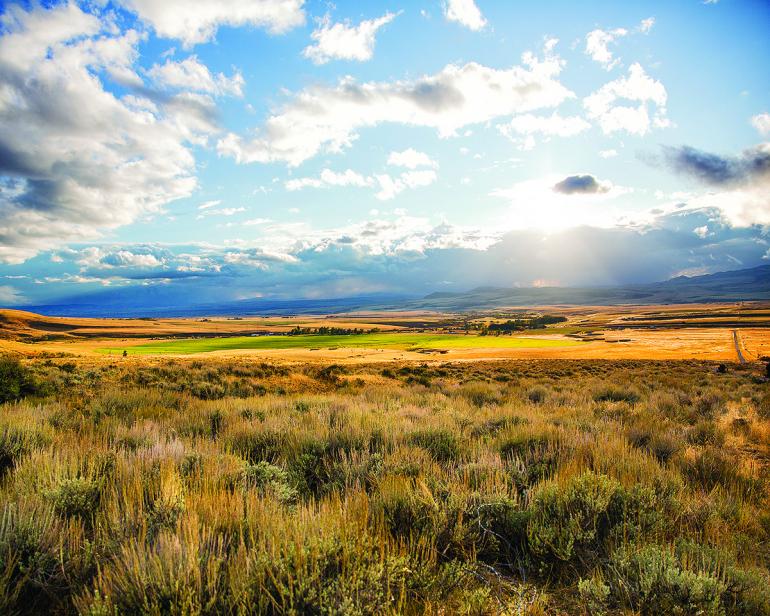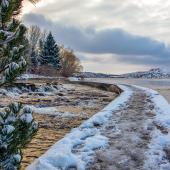Killing Fields
Beauty in the river bottom.
Winter’s onset had cost the landscape the brilliant colors I’d enjoyed so much on opening day. The golds and oranges along the river’s banks were gone now, replaced by the somber tones and oblique lighting of a Russell Chatham painting. But beauty lies in the eye of the beholder, and I could still see plenty of it: ideal upland-bird cover; a stately whitetail buck that had survived another deer season; a distant flock of mallards silhouetted against the dull December sky. What more could a guy like me ask for?
Montana offers the outdoor enthusiast a remarkable array of wildlife habitats, from alpine meadows to sagebrush steppe, sometimes within a few miles of each other. It’s all big country, however, and hunters headed to the field each fall should remember Sutton’s Law. When a reporter asked the notorious bandit Willy Sutton why he robbed banks, Sutton replied, “Because that’s where the money is.” For hunters in search of game, the money often lies in the bottomlands close to Montana’s numerous creeks and rivers.
This association reflects basic wildlife biology. Aldo Leopold identified four essentials for wildlife to thrive: food, water, cover, and clean air. While Montana’s air is largely the same throughout the state (with a few unfortunate exceptions), the other three essentials of wildlife habitat are often concentrated in bottomlands—the fields, forests, and brush along creeks and rivers.
The abundance of water in these areas is obvious by definition, but that water is more than a resource for wildlife to drink. Moisture supports the growth of trees and brush crucial as security cover for species as diverse as ring-necked pheasants and whitetail deer. Furthermore, the agricultural activity it supports provides a concentrated source of nutrition that often attracts game from miles away.
There are practical advantages to hunting bottomland terrain in addition to the abundance of wildlife it supports. Long expeditions are often unnecessary, allowing hunters to get into the field before and after work. Covering it on foot is easier (and safer) than backcountry mountain hunting. Dragging a deer out of an alfalfa field is easier than packing one out of a steep canyon, creating more options when deciding whether or not to shoot.
There are disadvantages as well, beginning with the likelihood of encountering more hunters. Perhaps more importantly nowadays is the fact that much of this terrain lies in private hands, obligating hunters to seek permission for access. Most Montana land managed by the federal government wound up in public hands by default, since its limited agricultural value meant no one wanted it much during the homestead era, which was not the case with bottomland.
There are ways around this dilemma, though, above and beyond knocking on doors and relying on friendships in the agricultural community. The first is Montana’s Block Management program, overseen by Montana Fish, Wildlife & Parks (FWP). Funded by revenue from non-resident license sales, this program allows hunters access to private land at no cost and little hassle. Visit your nearest FWP office or fwp.mt.gov prior to the season for current information and maps of property enrolled in the program.
Second, don’t overlook state lands. When Montana was surveyed at the time of statehood, two sections in every township were deeded to the state as a source of school revenue. Since private parties didn’t get to cherry-pick these sections, many of them include prime creek-bottom wildlife habitat. A digital property-ownership tool (such as OnX Maps) can prove invaluable.
While you can find almost any legal Montana game species in river bottoms, these locations are especially attractive to some. Pheasants are an excellent example. While I’ve shot pheasants in a variety of habitats, the large concentrations that produce the most exciting shooting have almost always come from creek bottoms. Lewis and Clark stopped seeing white-tailed deer by the time they reached what is now Montana, and their current abundance is largely dependent upon agricultural development near creeks and rivers. Elk will travel miles to feed in alfalfa or hailed-out grain (although they may not be there during shooting light). Waterfowl are a potential bonus anytime, no matter what your original quarry.
So, do your homework and hunt where the money is—near Montana’s creeks and rivers.












